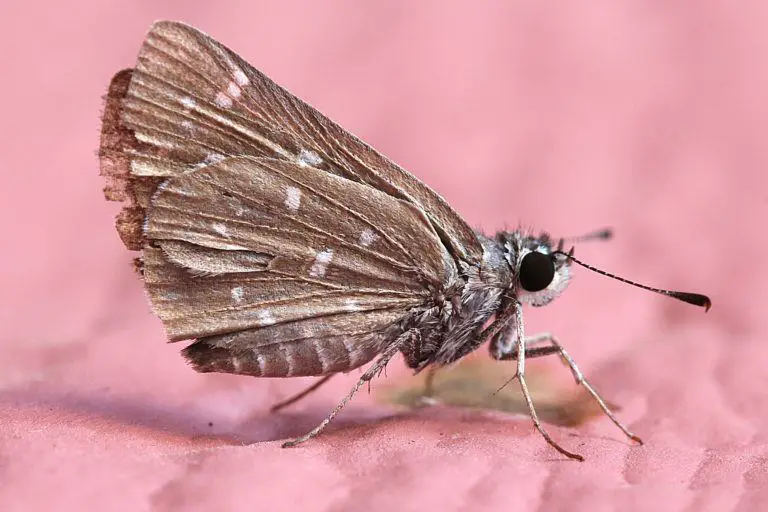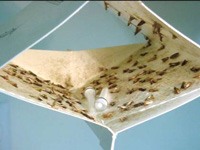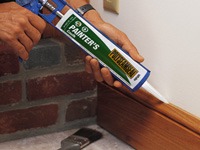
House moths fall into two equally distressful categories: moths that infest foods and moths that infest fabrics (like woolens, synthetics containing wool, furs, and sometimes silks and other fabrics). If you’re having problems in the pantry or kitchen, you’re probably dealing with the Indian meal moth, Angoumois grain moth, or Mediterranean flour moth. If your woolens are under attack, you’re fighting either the webbing clothes moth or casemaking clothes moth. Some moths – like the brown house moth – will happily spoil both your Cap’n Crunch and virgin-wool briefs.
So how do these silent-winged villains get into our homes? Well, they are often introduced via contaminated food or clothing. This is why it’s a good idea to inspect pantry staples (I also avoid bulk bins for rice, nuts, and grains) and used clothing. House moths can also be introduced by larger pests such as rodents or birds. Moth larvae feast on their feathers or hair, and pantry moth larvae can hatch from the nuts and grains they bring to their nests. Do some looking around in the dark corners of your home. The fun, however, may have started when one egg-toting moth made it into your home. What luck! Whatever the case may be, in this article you will find how to get rid of moths as well as prevent future infestations using safe, research-based strategies.
Best Moth Control Methods

Use pheromone moth traps to get rid of moths.
A variety of pheromone-based moth traps have come out in recent years. Set them out in infested areas and watch as moths throw themselves at the sticky graveyards, never again to lay another egg in your oatmeal. While these traps kill moths safely and effectively, different species react only to specific pheromones. Knowing the exact species you’re dealing with and purchasing accordingly is best. However, traps labeled for “pantry moths” or “clothes moths” will usually contain all the pheromones needed to attract the major species that fall under each category. Pro-Pest, Safer Brand, and EnviroSafe all make effective pheromone traps for both pantry moths and clothes moths.

Vacuum to get rid of moths.
Regular, vigorous vacuuming is essential for getting rid of moths. Even if you store foods and woolens correctly (bottom), moth larvae will feast and thrive on crumbs, pet and human hair, dead insects, lint, and other such rubbish. Besides reducing available food, the vacuum is great for catching adults and pulling hard-to-see moth larvae, eggs, and pupae from carpets, fabrics, and out-of-reach places. Using a machine with a HEPA filter and all the attachments at your disposal, get into important areas: underneath furniture, along walls and in corners, carpets and carpet perimeters, drapes, rugs, window sills, drawers, closets, shelving, cupboards, cracks, crevices…etc.

Use extreme temperatures to get rid of moths on garments.
Clothes moth larvae and eggs are easily destroyed with the use of a freezer. Place the infested item in a plastic bag, removing as much air as possible before sealing it inside. After four days, the merciless cold will have killed all moth eggs, larvae, and pupae. Just be sure to let the item warm up before taking it out of the plastic. The heat and agitation produced by ironing or machine drying an item will also destroy or dislodge eggs and larvae, destroying future moths.
Keep humidity low to control moths.
House moths thrive in humid conditions. If your home or room is at a relative humidity at or above 70% (which is as muggy as a fat man’s crotch on the 4th of July…I mean, c’mon), the moths will eat, reproduce, and develop at alarming rates. With the aid of a dehumidifier or air conditioner, bring the relative humidity down to 50% or lower. This will create an environment unfriendly to moths, hordes of other insect pests, and sweat stains. You can monitor humidity levels with a quality hygrometer – available at any hardware store.

Seal off moth hideouts using silicone caulk (or putty, foam).
House moths avoid our many attempts to kill them by hiding in the cracks and crevices in our homes. If you take these hideouts away, you lower your home’s moth population potential and increase the chances that moths and moth larvae will be killed by your vacuum, traps, and other tactics. Whether you’re in the kitchen, pantry, or closet, look to seal off cracks and crevices created by cabinets, trim, baseboards, shelving, flooring, drawers…etc. If possible, also seal off any place crumbs and filth tend to build up.
Moth Control Chemicals
In most situations, pesticides are not needed to get rid of moths and are discouraged. Moths infest highly sensitive areas – areas near food and clothing. However, severe infestations require bold actions. Insecticidal dusts such as Borid Boric Acid Dust or PyGanic 1% Pyrethrin Dust can safely be used for cracks, crevices, inside trim, wall voids, carpeting edges – anywhere moths, larvae, and eggs might hide. An aerosol spray like D-Force HPX will work just as well in those areas. For longer lasting moth control in dressers, wardrobes, closets, and under furniture, microencapsulated products like Demand CS (Lambda-cyhalothrin 9.7%) are often recommended.
Best Ways to Get Rid of Moths Naturally
Use natural moth repellents, not mothballs.
Traditional mothballs, which either contain naphthalene or PDB (paradichlorobenzene), are toxic to both moth and man alike. Instead of impregnating your clothes with these nasty chemicals, try a natural repellent or fumigant. Cedar chips, blocks, and cedar oil sachets (fumigants) are great for long-term storage of sensitive fabrics. My natural repellent (also fumigant) of choice is camphor, which comes in flake, ball, or cake form. Amazon sells Camphor Block tablets specifically for this type of pest. For pantry moths, try placing cloves, eucalyptus, bay leaves, or dried lemon peels near pantry foods.
Use food-grade diatomaceous earth.
This stuff is a great non-toxic, kid-and-pet friendly alternative to insecticides. Because it’s food grade, it can safely be used around clothes and food. Sprinkle an extra-fine layer of this stuff around infested areas and inside cracks and crevices. To you it will feel like talcum powder, but to moths and larvae, it is jagged glass. They move over it, start leaking, despair, and die.
Moth proof your home.
For moths, gaping door gaps and dilapidated windows are like a blindingly neon-red carpet. Apply weather stripping and door sweeps to doors. Fix screens with silicone caulk or screen patches. Tour the outside of your home (best done with a cold beer). Look for other ways the moths might trespass.
Make your own clothes moth traps.
Laying down plain, cheap sticky traps for rodents and insects in corners and along walls, cupboards, and shelving will catch roaming (worming?) moth larvae, but you can also make moth traps that will attract adults. You’ll need fly paper or whitefly paper, a cotton ball or two, and for the attractant, fish oil (from tuna, sardines…). Dab a cotton ball in the fish oil and stick it to the fly paper. Hang two or three of these in your closet or place them along walls or drawers.
Make your own pantry moth traps.
I know of two ways to make pantry moth traps – both kill moths. The first method is simple. Place a small amount of the type of food the moths are after on plain, cheap sticky traps, and place them strategically. For the other trap, mix 1 part boric acid (Borax) with 3 parts cornmeal. Glop the paste on jar lids and place strategically around stored foods.
Storing Woolens and Foods for Moth Control
Proper storage of foods.
To protect food and prevent future infestations, store items in moth- proof containers. Cardboard, thin plastic and paper will NOT keep them out. Jars that close with clamps and rubber gaskets are best. Plain screw-top jars will work, but only if they have a rubber stopper. Hard plastic containers also do the job as long as the seal is air tight (like these Rubbermaid Modular containers at Amazon). The freezer and fridge are also moth-safe zones. During an infestation, many people will keep items in the freezer until needed. If you think an item is moth-free but you need certainty, put it in a plastic bag, seal it with tape, and freeze it for four days. This will certainly kill any moth larvae or eggs.
If you’re under siege by pantry moths, swiftly begin a campaign of retribution. Throw away all infested foods as well as items you’re uncertain about. Look for the frass (can look like colored sand) and webbing indicative of moth larvae, which will create clumps in caked staples like flour. Next, clean all infested areas with soap and water, and vacuum thoroughly. Then you may want to do it again, especially if it is a wooden drawer or something similar. Moth larva are quite tricky.
Proper storage of clothing and fabrics.
Clothes moths need more than the keratin found in woolens to truly thrive. They need a hide, food or urine stains, sweat, or dead skin to satisfy the nutritional requirements needed to produce successive generations. So keeping woolens clean will lend them some protection. Moth larvae and eggs are also very fragile (adult moths don’t eat woolens; they just have sex and lay eggs). This is why items that are consistently used rarely suffer moth damage. If you’re not going to use an item, take outside and shake it out and beat it twice monthly. You can curse at it as well just to keep the neighbors at bay. Heirlooms and out-of-season items should be stored properly, and this is how it’s done:
Before storing an item, make sure it is free of moth larvae and eggs or you’ll be trapping your enemies in Nirvana for the winter. For storage, you need any sound, impenetrable barrier. Heavy duty plastic bags will work when sealed with heat or tape. Plastic containers that slide under beds perform well, but I’d tape the edges. A sturdy box will work too, provided any openings are sealed with tape. Professionals in shops and museums wrap susceptible items in thick craft paper and tape seams and edges. Whatever you choose, you can add a layer of protection by using moth repellents or fumigants. Just be sure to wash and air out items before using them again.
What are Moths Good For?
After spending 2,000 words discussing how to get rid of moths, I should mention that moths aren’t all bad. Moths can be useful pollinators, and in the caterpillar stage they do an important task of aerating soil. Additionally, did you know that the cocoons from moths are used to make silk? The next time you use a silk scarf or tie, remember that it came from a moth.